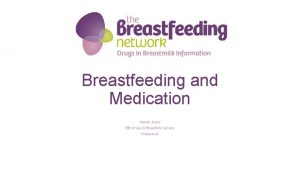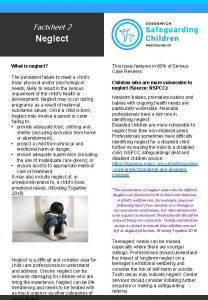Factsheet 2 Neglect What is neglect The persistent


- Slides: 2

Factsheet 2 Neglect What is neglect? The persistent failure to meet a child’s basic physical and/or psychological needs, likely to result in the serious impairment of the child’s health or development. Neglect may occur during pregnancy as a result of maternal substance abuse. Once a child is born, neglect may involve a parent or carer failing to: • provide adequate food, clothing and shelter (including exclusion from home or abandonment); • protect a child from physical and emotional harm or danger; • ensure adequate supervision (including the use of inadequate care-givers); or • ensure access to appropriate medical care or treatment. It may also include neglect of, or unresponsiveness to, a child’s basic emotional needs. (Working Together 2018) Neglect is a difficult and complex area for child care professionals to understand address. Chronic neglect can be seriously damaging for children who are living the experience. Neglect can be life threatening and needs to be treated with as much urgency as other categories of This issue features in 60% of Serious Case Reviews. Children who are more vulnerable to neglect (Source: NSPCC): Newborn babies, premature babies and babies with ongoing health needs are particularly vulnerable. Neonatal professionals have a key role in identifying neglect. Disabled children are more vulnerable to neglect than their non-disabled peers. Professionals sometimes have difficulty identifying neglect for a disabled child further increasing the risks to a disabled child. NSPCC safeguarding/ deaf and disabled children source: https: //learning. nspcc. org. uk/safeguarding -child-protection/ddeaf-and-disabledchildren/ “The assessment of neglect cases can be difficult. Neglect can fluctuate both in level and duration. A child’s welfare can, for example, improve following input from services or a change in circumstances and review, but then deteriorate once support is removed. Professionals should be wary of being too optimistic. Timely and decisive action is critical to ensure that children are not left in neglectful homes. Working Together 2018 Teenagers’ needs can be missed especially where there are younger siblings. Professionals should understand the impact of longterm neglect on a teenager’s emotional wellbeing and consider the risk of self-harm or suicide. Tooth decay may indicate neglect. Dental services should consider initiating further enquiries or making a safeguarding 1 referral.

show an interest in the child’s education Key questions when dealing with at school, support their learning, or neglect respond to any special needs? Do they comply with state requirements 1. Persistence and change: Is the level regarding school attendance. of neglect persistent over time and resistant to change, despite intervention 3. Impact of neglect on child and support? Does it persist over family their lived experience: What is the generations? Do parents want to child’s point of view, their voice? From change? What is their level of ability to the evidence before the professional, change? what can be predicted for the child’s future? Is the neglectful care enabling 2. Areas of the child’s developmental other kinds of abuse? needs affected: Are there aspects of neglectful care-giving? 4. Causal Factors: Neglect is most likely to result from a complex interplay • Physical care: Are carers providing of factors affecting the parents. Was appropriate clothing, food, cleanliness there maltreatment when parents were and living conditions? children? Learning • Emotional relationships, love, and the difficulties/disabilities, domestic abuse, attitudes of the parents to the child. Is substance or alcohol misuses? Poor the carer responsive to a child’s basic mental health, social isolation, poverty? emotional needs, including interacting with the child and providing affection? 5. Acts of Omission or Commission: Are they failing to develop a child’s self. Do the parents accept that there is a esteem and sense of identity? When problem? Do they blame others or hold lacking, this is likely to result in poor brain development, sense of inferiority, the child responsible? and low achievement. • Health and medical needs. Do carers 6. Parents of disabled children: Do minimise or deny child’s illness or health the parents understand the additional needs? Do they fail to seek appropriate needs of the disabled child? Are they medical attention or administer accessing the appropriate support for medication and treatments? the child to meet their additional • Supervision, guidance and safety. Is the needs? If not, is that reasonable and child left to cope alone? Are they left what is the impact of this on the child? with inappropriate carers? Do carers fail There is a risk of professionals being to provide appropriate boundaries about reluctant to challenge the parents of a behaviours’ such as under-age sex or disabled child and becoming parent alcohol use? focused in the assessments/ • Stimulation and education: Do carers interventions “Professionals were tolerant of dangerous conditions and poor care and some children’s provide a stimulating environment and demeanour and behaviour were optimistically interpreted as ‘happy and playful’, when they were living in an unsafe environment and had signs of poor developmental progress. ” Neglect and Serious Case Reviews – University of East Anglia & NSPCC Acknowledgement: Thanks to the Swindon Safeguarding Children Board (SSCB) for allowing the GSCP to adapt the information in this factsheet from one of their publications. Greenwich Safeguarding Children Partnership ' 020 8921 4477 * 1 st Floor The Woolwich Centre, 35 Wellington Street, London SE 18 6 HQ 2 8 www. greenwichsafeguardingchildren. org. uk



